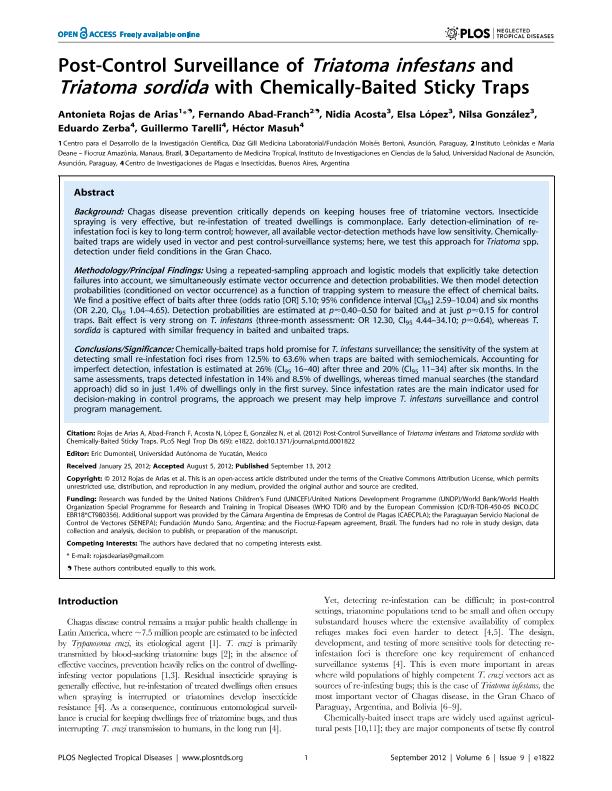Artículo
Post-Control Surveillance of Triatoma infestans and Triatoma sordida with Chemically-Baited Sticky Traps
Rojas de Arias, Antonieta; Abad Franch, Fernando; Acosta, Nidia; López, Elsa; González, Nilsa; Zerba, Eduardo Nicolás ; Tarelli, Guillermo; Masuh, Hector Mario
; Tarelli, Guillermo; Masuh, Hector Mario
 ; Tarelli, Guillermo; Masuh, Hector Mario
; Tarelli, Guillermo; Masuh, Hector Mario
Fecha de publicación:
09/2012
Editorial:
Public Library of Science
Revista:
PLoS Neglected Tropical Diseases
ISSN:
1935-2735
Idioma:
Inglés
Tipo de recurso:
Artículo publicado
Clasificación temática:
Resumen
Background: Chagas disease prevention critically depends on keeping houses free of triatomine vectors. Insecticide spraying is very effective, but re-infestation of treated dwellings is commonplace. Early detection-elimination of re-infestation foci is key to long-term control; however, all available vector-detection methods have low sensitivity. Chemically-baited traps are widely used in vector and pest control-surveillance systems; here, we test this approach for Triatoma spp. detection under field conditions in the Gran Chaco. Methodology/Principal Findings: Using a repeated-sampling approach and logistic models that explicitly take detection failures into account, we simultaneously estimate vector occurrence and detection probabilities. We then model detection probabilities (conditioned on vector occurrence) as a function of trapping system to measure the effect of chemical baits. We find a positive effect of baits after three (odds ratio [OR] 5.10; 95% confidence interval [CI95] 2.59-10.04) and six months (OR 2.20, CI95 1.04-4.65). Detection probabilities are estimated at p ≈ 0.40-0.50 for baited and at just p ≈ 0.15 for control traps. Bait effect is very strong on T. infestans (three-month assessment: OR 12.30, CI95 4.44-34.10; p ≈ 0.64), whereas T. sordida is captured with similar frequency in baited and unbaited traps. Conclusions/Significance: Chemically-baited traps hold promise for T. infestans surveillance; the sensitivity of the system at detecting small re-infestation foci rises from 12.5% to 63.6% when traps are baited with semiochemicals. Accounting for imperfect detection, infestation is estimated at 26% (CI95 16-40) after three and 20% (CI95 11-34) after six months. In the same assessments, traps detected infestation in 14% and 8.5% of dwellings, whereas timed manual searches (the standard approach) did so in just 1.4% of dwellings only in the first survey. Since infestation rates are the main indicator used for decision-making in control programs, the approach we present may help improve T. infestans surveillance and control program management.
Palabras clave:
Triatoma Infestans
,
Semiochemicals
,
Sticky Traps
,
Chagas Disease
Archivos asociados
Licencia
Identificadores
Colecciones
Articulos(UNIDEF)
Articulos de UNIDAD DE INVESTIGACION Y DESARROLLO ESTRATEGICOS PARA LA DEFENSA
Articulos de UNIDAD DE INVESTIGACION Y DESARROLLO ESTRATEGICOS PARA LA DEFENSA
Citación
Rojas de Arias, Antonieta; Abad Franch, Fernando; Acosta, Nidia; López, Elsa; González, Nilsa; et al.; Post-Control Surveillance of Triatoma infestans and Triatoma sordida with Chemically-Baited Sticky Traps; Public Library of Science; PLoS Neglected Tropical Diseases; 6; 9; 9-2012; 1-10
Compartir
Altmétricas



